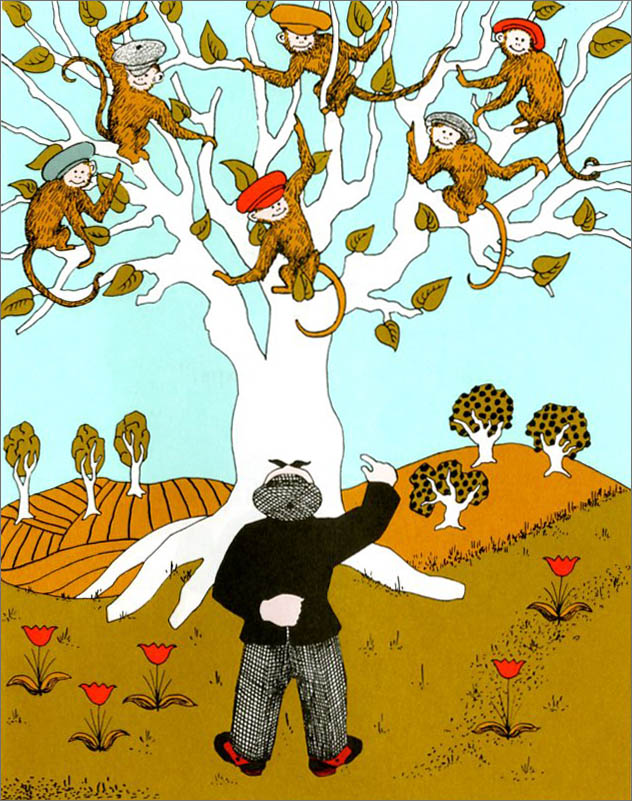Today's post is brought to you by Jaimie Howe.
Image taken from this source.
Like the peddler in Caps for Sale (retold by Esphyr Slobodkina), I wear many hats as a literacy coach. The hats that I wore when I first started as a literacy coach have evolved over the last few years. The hat that I wore most often in my first year as a literacy coach was interventionist. I spent probably 75% of my day working with struggling readers. The other 25% of my day, I wore a few other hats: mostly staff developer and data analyzer. The staff developer portion of my job was solely tied to supporting the K-5 teachers in my building in using our new curriculum. The data analyzer portion of my job was just that - analyzing a lot of data and not a lot of sharing or using of the data. I had many other hats that I wanted to wear such as coach, mentor, collaborator, modeler, observer, and leader.
At times I put them on and tried to “sell” them like the peddler in Caps for Sale did. Similar to the peddler, I didn’t have many takers. A large part of the problem I believe was a lack of understanding of what the title “coach” meant not only by the teachers in my building, but by district personnel as well. When I became a literacy coach, it was the first year the district had coaching positions. There were 13 of us; one at each elementary school. The good news was we were all learning together and collaborating as coaches. The first year was spent building relationships with the teachers in our buildings and the administrators we each worked under. As our relationships grew, the understanding of what we wanted our coaching to look like grew as well.
I started my second year as a coach with the intention of wearing my interventionist hat 50% of the time or less and wearing my coaching hat for a majority of the remainder of my time. The percentages didn’t necessarily add up to what I had hoped; however, my coaching position did evolve. A major step forward in my second year was establishing grade level collaboration meetings with the teachers in my building. I met with each grade level once a month. I tried to focus these meetings more on the Common Core State Standards (CCSS) and assessment. I was a collaborator, facilitator, professional developer, and even a coach at any given time during these meetings. The district I work for also sent all of the literacy coaches and elementary principals to Wisconsin’s RtI Systems Coaching six day workshop as well as a six day Professional Learning Community (PLC) workshop. I used information gleaned from these workshops to support and enhance my grade level collaboration meetings. About half way through the year I started using a protocol. At first, the protocol helped me remember each month where I had left off the month before, pretty much just keeping me organized. I also learned to differentiate my coaching based on the specific needs of each grade level. I met them where they were and tried to show them that I was a support for them, not just someone else telling them what to do. Through these collaboration meetings, I was continuing to build relationships and build the teachers’ understanding of my role as a “coach” and/or support.
As I began my third year as a literacy coach this year, I was hopeful, yet unsure of exactly how much more coaching I would be able to do. I was relieved and somewhat surprised to find most of the teachers in my building refreshed as the school year started. They had the summer to recuperate and were ready to start anew. I had teachers wanting to know more, wanting to understand how they could take the CCSS and immediately implement best teaching practices into their classrooms, wanting to understand how they could create common formative assessments that would align to the CCSS and their grade level report card. I was invited in to help, support, teach, model, and ultimately “coach.” I was ecstatic, overjoyed, and ultimately overwhelmed. My schedule has never been more booked. I am teaching (modeling) each of the six Notice and Note signposts in all 3rd-5th grade classrooms and our monthly collaboration meetings focus around a book study of this book (Notice and Note: Strategies for Close Reading by Kylene Beers and Robert E. Probst) and how it aligns to CCSS, formative assessment, rigor, etc. I am modeling and observing lessons based around the components of balanced literacy for eight weeks in first grade and eight weeks in kindergarten. I would say that my role has almost flipped from my first year as a literacy coach. I am now spending at least 75% of my time actually “coaching.”
Image taken from this source.
As I venture further into this third year of literacy coaching I relate to this photo from Caps for Sale. The monkeys are the teachers (I know great analogy ☺) and they are wearing many of my caps. They have asked for my support (my caps) and are using what they have learned through my modeling, observing, and collaborating to improve their teaching and increase student learning.
In my collaboration meetings I now use a more focused protocol based on the four essential questions. We actually use the data that I analyze. We analyze it together and use it to inform instruction. This new protocol keeps our meetings focused, data driven, and student centered as well as continues to keep me organized.
Click on the link above and view a sample of the protocol that I use. Let me know what you like about it, what you may use, and what could be added to make it better.





No comments:
Post a Comment
Comments are moderated. Your comment will appear after approval by this blog's editor.